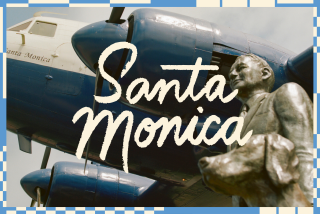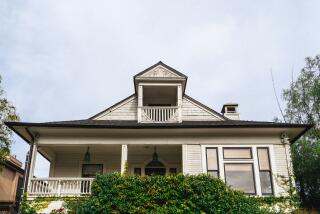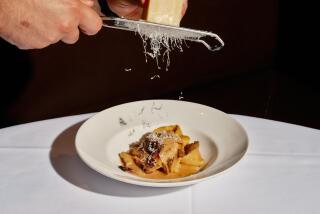Loving Naples, flaws and all
NAPLES, Italy -- Maybe I fell in love with this messy, intemperate city by the bay because I first saw it after spending a week in well-ordered Germany. Maybe I feel close to my familyâs southern Italian roots here. Or maybe Iâm just drawn to underdogs.
Naples, a city of about a million people, is definitely that; it was all but off the map for travelers in recent decades because of crime, poverty, decay and disasters like a 7.2-magnitude earthquake of 1980 that killed nearly 5,000 people and damaged many of the cityâs historic facades. Even adventurous travelers who knew of Naplesâ extraordinary churches and museums ventured here warily and came away with tales of pickpockets and purse-snatchers.
But the cityâs fortunes have been changing. Recognizing a need to save its many treasures-including its glass-roofed Galleria Umberto and vast Capodimonte museum-local power brokers about 15 years ago embarked on a campaign to save Naples. Museums, palaces, piazzas, churches and cloisters were renovated, and car traffic was banned in certain neighborhoods. Police were posted in tourist areas, like Spaccanapoli, the cityâs dense, dark historic center whose secretive splendors partly inspired the old maxim, âSee Naples and die.â
Meant to express the sublime effect of the city on tourists, the saying has another, more literal meaning I wanted to avoid. When I visited Naples last September, I found it still noisy, dirty and discombobulating. But I had prepared for the trip as if I were going to a Third World country, girdling my middle in a money belt and hiding my camera in an over-the-shoulder bag. I prepared mentally as well. While there, I went out alone at night, but I always watched my back, and I stayed away from the poor, crime-ridden Spanish Quarter, a fugue of alleys on the flank of the Vomero, one of the hills that dumps the city into the sea.
And I never once felt ill at ease.
âViolent crime against Americans in Naples is very rare,â says Gloria Berbena, who is with the U.S. Consulate in Naples. âWhile there certainly is petty crime, it is not anything different than what American tourists would find in other major European cities.â
Those willing to take the kind of precautions I did are amply rewarded by the cityâs art and architecture, nearby archeological showplaces like Pompeii and Herculaneum, and a feast of irresistible food. Others who prefer to see the city while staying elsewhere can station themselves on the Amalfi coast, an easy day trip by train. But it would be a great pity to avoid La Bella Napoli altogether, if only because its National Archeological Museum provides such an excellent introduction to the wonders of nearby Herculaneum and Pompeii, covered in ashes and rubble and thus preserved for posterity by a massive eruption of nearby Mt. Vesuvius in AD 79.
Italians say that Naples is real, edgy and unvarnished in the way that tourist-choked Rome and Florence are not. At almost every turn, Naples made me think of the old courtesan Madame Hortense in âZorba the Greek,â at once so charming and so pathetic that she constricts the heart.
Throughout most of the cityâs long history, the port of Naples sang a siren song to visitors, beginning with the Greeks and Romans, who built vacation villas in the lush, sunny countryside around it. Now many of these are archeological digs, but Naples endures in its unmatched setting, with perfectly proportioned Vesuvius, Europeâs only active volcano, on the horizon, the Sorrento peninsula to the south and the fabled island of Capri out in the Tyrrhenian Sea. And then thereâs that mesmerizing azure bay, which kept me looking seaward.
Whenever you manage to wrest your gaze from the view, there are the gratifications of art. But you donât come to Naples principally to see masterworks of the Renaissance, as in Florence, or antique splendors like those in Rome. Because Naples was ruled by a long train of foreign suzerains, from the Greeks and Romans to the Goths, Normans, Spanish and French, it is an artistic mishmash, demonstrating almost every style that hit the Italian boot but especially the Baroque and Neoclassic, which may be acquired tastes.
Still, those who turn up their noses at those styles might reconsider if they could see Giuseppe Sammartinoâs uncanny, haunting sculpture of the âVeiled Christâ in Spaccanapoliâs Sansevero chapel and the grand, cantaloupe-colored Palazzo Reale, occupied in the 18th century by one of the first resident kings of Naples, Charles of Bourbon, and later by Napoleonâs brother-in-law, Joachim Murat.
Nor is Naples the place for passing time in a cafe on a quiet, traffic-free piazza. Despite efforts to make the city more tourist friendly, traffic remains relentless. Cars, vegetable trucks and motorcycles, driven at breakneck speed over curbs and down railway tracks, whether or not thereâs a train in sight, have the right of way, it seems. So you must watch your toes at intersections, take it for granted that youâll be breathing exhaust fumes and bolt the shutters and windows tight if you need quiet to sleep.
Donât go to Naples to make friends, either. Italians, and particularly Neapolitans, seem to me far too self-absorbed to be gregarious. Itâs lovely, though, to watch them gesticulating on street corners with their snazzy jackets draped over their shoulders or sleeping on sunny park benches in the middle of a workday afternoon.
Kissing is an endurance sport here. Iâd walk past a couple on the Piazza Plebiscito or the Santa Lucia waterfront on my way to dinner, and when I returned after my meal, they were still locked at the lips.
Neapolitans eat with sensual abandon, too, which is perfectly understandable given the food: margherita, the standard Neapolitan pizza, a simple tomato-sauce-and-cheese style that they often fold in half and consume as theyâre walking down the street; gelato richer than Ben and Jerryâs ice cream; the fresh mozzarella found in salads that tastes subtly different every place you order it; and, of course, red sauces, starring the regionâs prized tomatoes. Neapolitan restaurants have scores of recipes for these sauces, flavored with everything from chile peppers to veal shank. Some days, it seemed as if I was simply killing time between meals.
The best meal I had was at Caffe Bellini on the edge of Spaccanapoli. It started with a half-bottle of a local white wine, Lacryma Christi (âtears of Christâ), and a tangle of fried calamari, followed by eggplant in red sauce, which was a triumph of simplicity.
I came to think of Bellini as my dining room because it is just down the street from the modest Albergo Sansevero, where I stayed for three nights. My room, which lay across the courtyard of the old palazzo that houses the main section of the inn, was spacious but spartan. I later discovered that chambers in the main section have more comforts and character.
Still, I had pretty, palm-shaded Piazza Bellini on my doorstep and was perfectly positioned for wandering in Spaccanapoli, which means âsplit Naples,â so named because of the way the neighborhoodâs main street (known variously as Via Pasquale, Benedetto Croce and San Biagio dei Librai) slices through the heart of the historic center. There, cafes and pizzerias, ancient churches like Baroque Ges Nuovo and Gothic Santa Chiara, archeological digs, food stalls and presepio workshops, where craftsmen make Naplesâ signature Christmas creche figures, are jammed together along impossibly narrow streets, lined with tenements and crumbling palazzos that let in only a thin ribbon of blue sky. The city flag-its drying laundry-flies from windows and balconies; waiters deliver morning coffee on trays to apartment-dwelling customers too tired to make it themselves; and in the early evenings, families gather in wine and lingerie stores, where toddlers play on the floor and babies are plopped on counters.
The hotel was also an easy walk up a gently sloping hill to the National Archeological Museum on jangling Piazza Cavour. Inside the museum, redesigned to house the Farnese collection of ancient sculpture and, later, many artworks unearthed at Herculaneum and Pompeii, all is quiet and astonishingly beautiful. Among its treasures are the stout-thighed Farnese Hercules, a Roman copy of an Athenian original; a lifelike mosaic of three sorceresses from the Villa of Cicero in Pompeii; and the âSecret Room,â where embarrassingly explicit Roman erotica is displayed. Naples is more than Spaccanapoli and the archeological museum, which became apparent to me on countless calf-wrenching forays up the Via Toledo to the Museum of the Capodimonte, with its Masaccios, Botticellis and Titians; to the top of the city at the 14th century monastery of San Martino, where I saw part of a Marcello Mastroianni film festival in the courtyard; through Castel Nuovo, with its Renaissance-style triumphal arch, and 12th century Castel dellâ Ovo on the Santa Lucia waterfront; and, in running shoes, across the Villa Comunale, a sedate oceanfront park in the tony Chiara section of town.
Besides the Albergo Sansevero, I stayed at two fairly luxurious hotels: the Miramare Hotel on the Santa Lucia waterfront and the Empire-style Grand Hotel Parkerâs, among mansions and funicular stations on the side of the Vomero. At the Miramare, my chamber, decorated with ugly white furniture, heavy drapes, mirrors and bizarre triangular light fixtures in the Italian Liberty style (known elsewhere as Art Nouveau), had two balconies overlooking the bay. At breakfast on the rooftop patio or from the tub in my big, tiled bath, I could make sure Vesuvius wasnât erupting. At Parkerâs, a refined, smoothly run place, I liked to sit in the sixth-floor bar, sip a drink and watch the bay.
This is a travelerâs Naples in a pignolia shell. But besides all this, there are the delightful surprises. Imagine, for example, buying a ticket to a ballet at the 18th century Teatro San Carlo, with its 12,000-square-foot stage, six-tiered auditorium and frescoed dome, and realizing youâve confused curtain time and missed most of the performance because youâve been drinking espresso in the Caffe Gambrinus across the Piazza Trieste e Trento. When you realize your mistake, you rush across the square, plead with an usher to let you in for the last act, and are admitted (for convenienceâ sake) to the royal box, all red velvet and gilt. When the curtain drops, you suddenly recognize the similarities between a royal box and a laundry-festooned balcony in Spaccanapoli.
You might wander into the cloister of the church of Santa Chiara off the Piazza Ges Nuovo, with its joyful majolica arbors, columns and benches; or to the Piazza San Domenico Maggiore, with its 18th century Neapolitan obelisk. This comfortable piazza is close to the church of San Domenico Maggiore, where Thomas Aquinas founded a school of philosophy in the 13th century, and the Caffe Scaturchio, which has been serving Naplesâ best baba au rhum from, I guess, time immemorial.
For travelers who come to the Campania region of Italy chiefly to see Pompeii and Herculaneum, paralyzed and preserved by Mt. Vesuvius, it may come as another surprise to learn about the Circumvesuviana. This efficient Neapolitan train takes commuters to the suburbs and tourists to the thresholds of Pompeii and Herculaneum for about $3. Herculaneum, the site of the Villa of the Papyri, which was a model for the old Getty Museum in Malibu, is somewhat closer to Naples than Pompeii is, but itâs an archeological disaster, surrounded by a fetid moat and melting under the southern Italian sun.
Pompeii, on the other hand, is a glory, with its perfect amphitheater, strange temple to the Egyptian cult of Isis and extraordinary wall paintings, which show us where the Neoclassicism of the Grand Hotel Parkerâs came from.
Each visitor finds his own surprises in Naples. You need only a money belt and a love of Italy, which can be nowhere more intensely felt than in Naples. The city is the capital of pizza, Roman copies of Greek masterworks, recondite cloisters, stern castles, overblown Baroque palaces and octopus from the bay in their death throes, for sale on the streets of Spaccanapoli. The good and the bad, the gorgeous and ugly, all mixed up together, which, at the heart of it, is why I love Naples.
More to Read
Sign up for The Wild
Weâll help you find the best places to hike, bike and run, as well as the perfect silent spots for meditation and yoga.
You may occasionally receive promotional content from the Los Angeles Times.






